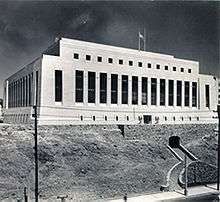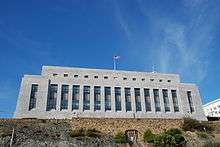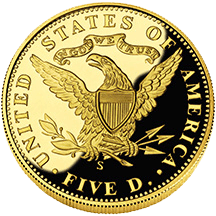San Francisco Mint
|
Old United States Mint (San Francisco) | |
|
The old San Francisco Mint building, built in 1874 | |
   | |
| Location | Fifth and Mission Streets, San Francisco, California |
|---|---|
| Coordinates | 37°46′58.0″N 122°24′25.8″W / 37.782778°N 122.407167°WCoordinates: 37°46′58.0″N 122°24′25.8″W / 37.782778°N 122.407167°W |
| Built | 1869 |
| Architect | Alfred B. Mullett |
| Architectural style | Classical Revival |
| NRHP Reference # | 66000231 |
| CHISL # | 875 |
| SFDL # | 236 |
| Significant dates | |
| Added to NRHP | October 15, 1966[1] |
| Designated NHL | July 4, 1961[2] |
| Designated CHISL | 1974[3] |
| Designated SFDL | 2003[4] |
The San Francisco Mint is a branch of the United States Mint and was opened in 1854 to serve the gold mines of the California Gold Rush. It quickly outgrew its first building and moved into a new one in 1874. This building, the Old United States Mint, also known affectionately as The Granite Lady, is one of the few that survived the great 1906 San Francisco earthquake. It served until 1937, when the present facility was opened.
Old Mint
Within the first year of its operation, the San Francisco mint turned $4 million in gold bullion into coins. The second building, completed in 1874, was designed by Alfred B. Mullett in a conservative Greek Revival style with a sober Doric order. The building had a central pedimented portico flanked by projecting wings in an E-shape; it was built around a completely enclosed central courtyard that contained a well—the features that saved it during the fire of 1906, when the heat melted the plate glass windows and exploded sandstone and granite blocks with which it was faced. The building sat on a concrete and granite foundation, designed to thwart tunneling into its vaults, which at the time of the 1906 fire held $300 million, fully a third of the United States' gold reserves. Heroic efforts by Superintendent of the Mint, Frank A. Leach, and his men preserved the building and the bullion that then backed the nation's currency. The mint resumed operation soon thereafter, continuing until 1937.
In 1961 the Old Mint, as it had become known, was designated a National Historic Landmark.[2][5] It also became a California Historical Landmark in 1974.[3]
The given name of "The Granite Lady" is somewhat of a misnomer as most of the building is made from sandstone. While the base/basement of the building is made of granite, the entire external and upper stories are made of sandstone. The Granite Lady was a marketing term given in the 1970s that stuck.
The Old Mint was open to visitors until 1993. In 2003 the federal government sold the structure to the City of San Francisco for one dollar—an 1879 silver dollar struck at the mint— for use as a historical museum to be called the San Francisco Museum at the Mint.
In the fall of 2005, ground was broken for renovations that would turn the central court into a glass-enclosed galleria. In 2006 Congress created the San Francisco Old Mint Commemorative Coin, the first coin to honor a United States mint (Pub.L. 109–230). The first phase of renovations were completed in 2011.
In 2014, the San Francisco Museum and Historical Society began raising money for the second phase, which would have included permanent exhibitions. In 2015, the City of San Francisco looked for a new tenant to renovate and program the space with Activate San Francisco Events being selected as an interim tenant.[6] As the City's 2016 public re-opening event, continuing the tradition of a similar event from past years, on the first weekend in March, the Old Mint hosted a "San Francisco History Days" event with over sixty participating historic organizations.[7] Until a new tenant is found, the Old Mint will continue to be used for special events, some open to the public. In April 2016, the California Historical Society agreed to undertake the restoration of the building and its preservation as a public space.[8]
New Mint


The new Mint was opened in 1937. Beginning in 1955, circulating coinage from San Francisco was suspended for 13 years. In 1968, it took over most proof coinage production from the Philadelphia Mint, but continued striking a supplemental circulating coinage from 1968 through 1974. From 1975 to 2012, the San Francisco Mint has been used only for proof coinage, with the exception of the Susan B. Anthony dollar from 1979–81 and a portion of the mintage of cents in the early 1980s. The dollars bear a mintmark of an "S", but the cents are otherwise indistinguishable from those minted at Philadelphia (which bear no mintmarks, unlike those years' proof cents from San Francisco and circulation cents from Denver). In 2012, the San Francisco mint started to mint circulation strike quarters in the America the Beautiful quarter series, marked with an "S" mintmark and only issued for collectors.
From 1962 to 1988, the San Francisco Mint was officially an assay office; the San Francisco Assay Office was granted mint status again on March 31, 1988 (Pub.L. 100–274).[9] The San Francisco Mint is located at 155 Hermann Street, but only admits visitors on rare exception. On May 15, 1987, a limited number of people were allowed to tour the facility. This tour was advertised in the San Francisco Chronicle newspaper, with a phone number to call to reserve a spot.
San Francisco Old Mint Gold
| United States | |
| Value | 5 U.S. Dollar |
|---|---|
| Mass | 8.359 g |
| Diameter | .850 Inches mm |
| Thickness | ? mm |
| Edge | Reeded |
| Composition | 90%Gold/10%Alloy |
| Years of minting | 2006 |
| Catalog number | ? |
| Obverse | |
|
| |
| Design | The "Granite Lady" San Francisco Old Mint. Inscriptions: '1906-2006', 'Liberty', E Pluribus Unum' & 'San Francisco Earthquake and Fire Centennial' |
| Designer | Charles L. Vickers |
| Design date | 2006 |
| Reverse | |
 | |
| Design | A replica of the 1906 Half-Eagle Coronet Liberty eagle reverse. Inscriptions: 'United States of America', 'In God We Trust', & 'Five D.' |
| Designer | Christian Gobrecht |
| Design date | 2006 |
In 2006, the United States Mint released a gold five dollar commemorative coin which commemorates the 100th year after the old San Francisco mint survived an earthquake. The mint also played a part in the city's recovery after the earthquake, providing shelter for many as it was one of the few buildings left standing.
The coin was minted as both a proof coin and an uncirculated coin, and is no longer available directly from the United States Mint. On June 15, 2006 President George W. Bush signed Public Law 109-230, legislation authorizing the production of the 2006 San Francisco $5 commemorative gold coin as well as its $1 silver counterpart. The production of the $5 denomination was limited to a maximum mintage of 100,000 coins, but separate mintage figures for each of the proof and uncirculated coins have not yet been released. The $1 silver version was limited to only 500,000 coins, both in proof and uncirculated products, but distinct mintage figures for both products has not been officially stated.
The obverse was designed by Christian Gobrecht and sculpted by Joseph Menna.
Features
Coin Finishes: proof, and uncirculated
Maximum Mintage: 100,000 - The final mintages were 16,938 uncirculated, and 47,275 proof.
United States Mint Facility: San Francisco (S)
Public Law: 109-230
San Francisco Old Mint
| United States | |
| Value | 1 U.S. Dollar |
|---|---|
| Mass | ? g |
| Diameter | 38.1 mm |
| Thickness | ? mm |
| Edge | Reeded |
| Composition | 90%Ag/10%Cu |
| Years of minting | 2006 |
| Catalog number | ? |
| Obverse | |
| Design | Old Mint "The Granite Lady", Instrumental in San Francisco's Recovery, 1906-2006, E Pluribus Unum, Liberty |
| Designer | Sherl J. Winter |
| Design date | 2005/6? |
| Reverse | |
| Design | Replica of the Morgan Silver Dollar Rev; United States of America, One Dollar, In God We Trust |
| Designer | George T. Morgan |
| Design date | 1904 |
In 2006, the United States Mint released a silver dollar commemorative coin which commemorates the 100th anniversary of the survival of the old San Francisco mint in the 1906 San Francisco earthquake.
The mint also played a part in the city's recovery after the earthquake.
The coin was sold as both as a proof coin and an uncirculated coin, with a maximum coinage of 500,000 coins.
Features
This coin has a design of the old San Francisco mint on the obverse and a replica of the 1904 eagle design of Morgan silver dollars on the reverse.
Coin Finishes: proof, and uncirculated
Maximum Mintage: 500,000 (at the time)
United States Mint Facility: San Francisco (s)
Public Law: 109-230
See also
References
- ↑ National Park Service (2007-01-23). "National Register Information System". National Register of Historic Places. National Park Service.
- 1 2 "Old United States Mint (San Francisco)". National Historic Landmark summary listing. National Park Service. Retrieved 2008-03-02.
- 1 2 "San Francisco Mint". Office of Historic Preservation, California State Parks. Retrieved 2012-10-14.
- ↑ "City of San Francisco Designated Landmarks". City of San Francisco. Retrieved 2012-10-21.
- ↑ James Dillon (March 30, 1976) National Register of Historic Places Inventory-Nomination: Old United States Mint, National Park Service and Accompanying six photos, exterior and interior, undated
- ↑ "S. F. Picks Events Company to Put Some New Life Into Old Mint". Retrieved January 12, 2016.
- ↑ "San Francisco History Days". Retrieved January 12, 2016.
- ↑ Johnson, Lizzie (1 April 2016). "Category:Failed museum proposals in the United States". San Francisco Chronicle. Retrieved 30 August 2016.
- ↑ "Timeline of the United States Mint". United States Mint. Retrieved April 20, 2010.
External links
![]() Media related to San Francisco Mint at Wikimedia Commons
Media related to San Francisco Mint at Wikimedia Commons
- Official San Francisco Mint website
- "US Mint Buildings Across the Nation: San Francisco Mint", US Treasury Department website, 2007.
- "New San Francisco Mint" article (1936)
- Michael Castleman, "Grace Under fire", Smithsonian Magazine April 2006, pp 56ff Mint Superintendent Frank Leach and his men saved the mint during the San Francisco fire, 1906.
- "The Second US Mint at San Francisco: Part One" Article
- General Services Administration page on the Old Mint, San Francisco
